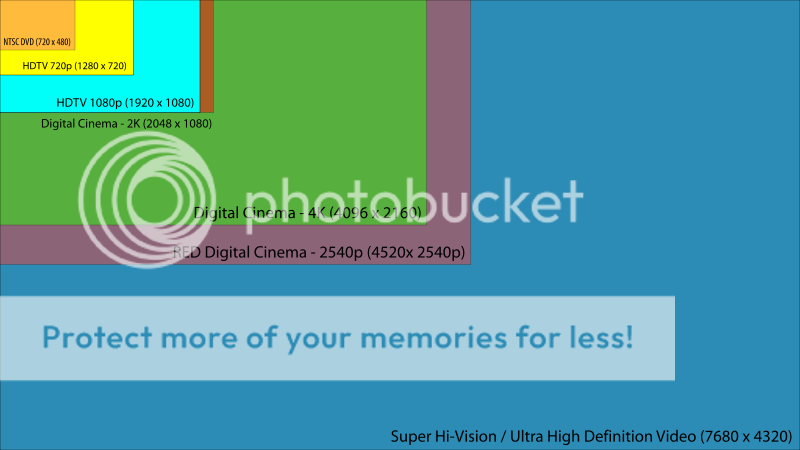HDTV vs. UHDTV
In order to better understand UHDTV, let's examine the details and discover the differences between it and HDTV. Here's a general breakdown of the standard television formats and their pixel power. For a closer look, read How HDTV Works.
We'll get into HDTV vs. UHDTV in a moment, but let's first examine the basic terms regarding television:

The plan is that ultra-high definition TVs will have 16 times the resolution of anything we currently have now in high definition. It'll be more than twice the resolution of 70 millimeter film, a commonly used format for IMAX movies [source: Hamasaki]. The projected images will be crammed with 32 million pixels, compared to the current HD experience that displays about two million pixels. With these huge numbers, not only is the image resolution exceptionally rich, the screen ends up being quite large. Developers expect the consumer versions will be between about 100 and 200 inches (254 and 508 centimeters) in size. Commercial versions -- possibly used for educational, security and advertising purposes at sporting events, art shows and museums -- would be more along the lines of about 350 to 600 inches (889 to 1,524 centimeters).
Despite the differences in resolution and frame rate, the current plan is to retain HDTV's aspect ratio of 16:9, as opposed to choosing a new one like IMAX developers did. This will help keep the new equipment compatible with HDTV broadcasts. Researchers believe that a wide viewing angle increases the sensation of immersion, although they also recognize the drawbacks that can come with a too-wide, too-realistic depiction of images. Studies into these phenomenon are being conducted to help guide UHDTV's development. For example, researchers examine the sensation of presence according to the width of the screen and the optimum angle and distance from which to view it.
Ultra-high definition images could also have a few drawbacks that researchers are trying to solve. For example, someone watching UHDTV might experience symptoms such as motion sickness depending on the stability of the image, the amount of visual stimuli and the visual angles he or she is viewing the TV at. On the production end of the process, Hollywood has already had to adjust to HDTV's unforgiving detailed image (the technology can magnify any wrinkles, pimples and facial imperfections) -- imagine the challenges make-up artists face if UHDTV becomes a mainstream format for movie viewing.
­Though we've delved a little deeper into the world of ultra-high definition TV, there's still super-advanced, high-tech goodness to learn about. Continue to the next page for an inside look at the cutting-edge mechanics of UHDTV technology.
source
In order to better understand UHDTV, let's examine the details and discover the differences between it and HDTV. Here's a general breakdown of the standard television formats and their pixel power. For a closer look, read How HDTV Works.
We'll get into HDTV vs. UHDTV in a moment, but let's first examine the basic terms regarding television:
- Resolution is determined by the number of pixels that are arranged horizontally and vertically across the screen. A pixel is the smallest possible individual point of light that makes up an image on a screen. Depending on the density of pixels (or dots per inch), the more pixels that comprise an image, the clearer it will become generally. The first number, 1920 for example, represents the number of pixels in each row running horizontally across the screen. The second number, 1080, refers to the amount of pixels in each vertical column. The second number also refers to the amount of scanning lines a screen has. UHDTV, for example, is reported to have 4,000 scanning lines.
- The aspect ratio describes the proportions of the width and height of the screen. Think of the difference between today's rectangular, slim TVs and the square-shaped screens of bulky TVs used 10 years ago -- those older models featured a 4:3 aspect ratio. Nowadays, you're likely looking at a TV with a 16:9 aspect ratio -- the same as a movie theater screen.
- The frame rate describes how many times per second the picture refreshes on the screen. The lowercase letter listed after the number indicates the manner in which this process is completed. The "i" means the image is interlaced: every other scanning line of pixels is refreshed, with the other half following suit. A "p" signifies the change is progressive, and the entire image is being refreshed constantly.

The plan is that ultra-high definition TVs will have 16 times the resolution of anything we currently have now in high definition. It'll be more than twice the resolution of 70 millimeter film, a commonly used format for IMAX movies [source: Hamasaki]. The projected images will be crammed with 32 million pixels, compared to the current HD experience that displays about two million pixels. With these huge numbers, not only is the image resolution exceptionally rich, the screen ends up being quite large. Developers expect the consumer versions will be between about 100 and 200 inches (254 and 508 centimeters) in size. Commercial versions -- possibly used for educational, security and advertising purposes at sporting events, art shows and museums -- would be more along the lines of about 350 to 600 inches (889 to 1,524 centimeters).
Despite the differences in resolution and frame rate, the current plan is to retain HDTV's aspect ratio of 16:9, as opposed to choosing a new one like IMAX developers did. This will help keep the new equipment compatible with HDTV broadcasts. Researchers believe that a wide viewing angle increases the sensation of immersion, although they also recognize the drawbacks that can come with a too-wide, too-realistic depiction of images. Studies into these phenomenon are being conducted to help guide UHDTV's development. For example, researchers examine the sensation of presence according to the width of the screen and the optimum angle and distance from which to view it.
Ultra-high definition images could also have a few drawbacks that researchers are trying to solve. For example, someone watching UHDTV might experience symptoms such as motion sickness depending on the stability of the image, the amount of visual stimuli and the visual angles he or she is viewing the TV at. On the production end of the process, Hollywood has already had to adjust to HDTV's unforgiving detailed image (the technology can magnify any wrinkles, pimples and facial imperfections) -- imagine the challenges make-up artists face if UHDTV becomes a mainstream format for movie viewing.
­Though we've delved a little deeper into the world of ultra-high definition TV, there's still super-advanced, high-tech goodness to learn about. Continue to the next page for an inside look at the cutting-edge mechanics of UHDTV technology.
source









 PSN ID
PSN ID

 by
by 








